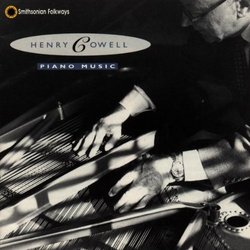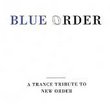.
01/21/2000
(4 out of 5 stars)
"Put a kid in front of a piano and the first thing they do is slam their fists onto the keys, creating an awful racket. That's what Henry Cowell as a mature composer earlier this century; he named the technique "tone clusters" and subsequently got famous for it. But that's not all: he reached inside the piano, plucked and strummed the strings creating eerie and gorgeous siren-like and harp-like noises. He often twisted the instrument into sounding like a full gamelan orchestra. Cage, Stockhausen, Zappa, Cecil Taylor and others took Cowell's cue and brought these techniques to radical extremes later in the century. This disc, recorded in 1963 shortly before his death, features Cowell at the piano banging out 19 short selections. The disc finishes with a fascinating blow-by-blow commentary where he described each selection on the disc and how he came to compose these revolutionary works"
Crumb, Ustvolskaya? No: Cowell was there before. Piano music
Discophage | France | 03/24/2007
(5 out of 5 stars)
"I had read in the textbooks about "Cowell the cutting edge experimenter and innovator" from the 1910s to '30s, but this was my first encounter with his early piano music - the other compositions I had previously heard from him were mostly conservative pieces. I wish I hadn't waited so long.
This is simply stupendous.
Many of these pieces are based on fairly simple modal folk or folk-inspired melodies, most of the times of Irish origin (the disc also contains a Japanese "Snows of Fujiyama"). Sometimes, in the music's chorale-like writing, you could be hearing a Busoni Bach-transcription ("Harp of Life"), Mussorgky's "The Great Gates of Kiev" ("Voices of Lir") or Albeniz' Iberia ("The Trumpet of Angus Og"). But then what you get as "accompaniment" (I am not sure it is the proper word) is breathtaking: deep tone clusters sometimes reaching two-octaves, as in "The Tides of Manaunaun", "Harp of Life" and "Voice of Lir", sounding like the deep rumbling or moaning of some mythological Celt God. Likewise, the tone-clusters of "Snows of Fujiyama" conjure a mysterious sound-world where the voices of nature intermingle with evocations of oriental bells with their complex and non-tempered overtones (there is also some of that in "Antinomy", where at one point the right hand apparently arpeggiates the keys so to produce the sound of a strummed harp.)
At its most exuberantly pounding Cowell's writing sounds like the early piano music of George Antheil, as in the dazzling "Advertisement" - but that was written some years before Antheil's piano sonatas - "Antinomy", "Amiable Conversation", "Jig" - but there is more to Cowell than pounding.
It is music of incredible evocative power and poetic invention. Cowell's appetite for bringing the inside of the piano out (quite literally, some times) results in uniquely eerie sonorities. I had thought George Crumb had invented the various techniques of string strumming and of altering the tone quality of the piano strings being struck by the hammers by placing the fingers at various points directly on the strings, as with guitar or violin. Not so: it is all there in Cowell, as early as the late 10s (try "Aeolian Harp", "Fairy Answer", "Sinister Resonance" and the mesmerizing "Banshee", of which it is difficult to think that it has NOT been composed by Crumb in the early '70s). I had thought that obsessive and angrily violent cluster pounding was a trademark of Shostakovich's maverick protégée Galina Ustvolskaya - no, it is all there in Cowell's "Antinomy" from 1914 (revised in 1959), in his 1916 "Dynamic motion" and his "Tiger" (c. 1928).
Though apparently Cowell "backdated" some of his early compositions, in an attempt to make them seem even more precociously innovative than they already were, to think that a 19 year-old youth was capable of such unbridled invention as marks the 1916 "Dynamic Motion" simply defies the imagination. There is something deeply moving about the sad fate of the early American modernists. The early 20th century United States harbored a string of great innovators - to Cowell one can add Ornstein, Antheil, Ives, to name but a few - that should have been greeted and hailed as beacons of a new era. Instead, they had to fight against an unwelcoming musical environment which ultimately succeeded in stifling or silencing their unique creative personalities. They were, of course, "rediscovered" from the 50s onwards (though, judging from this disc, Cowell's piano music doesn't nearly get the exposure it deserves). They were ahead of their times.
After about 48 minutes of music, the disc is topped off by an invaluable 13-minutes of commentaries by Cowell himself on the compositions featured therein, delivered with his inimitable accent. There can be no end to the praise that Folkways deserves for recording the composer playing his own works in 1963 (and the Smithsonian for reissuing it on CD), about two and ½ years before his death.
A check with the scores shows that Cowell often takes some liberties (leading some subsequent interpreters, such as Sorrel Doris Hays on Sorrel Doris Hays Plays the Piano Music of Henry Cowell, to follow the recording rather than the printed page in some of the pieces, such as "What's This") and strikingly so in "Advertisement" - so much so that no one seems to have dared reconstruct a score from the recorded version; a pity as, to say the truth, I find the recorded version better than the printed one, with more "Katzenjammer Comics"; the original sounds almost too civilized in comparison.
In some of the more digitally dynamic pieces (such as in "What's This"), the composer's fingers are a tad stiff, but discographic comparisons (Hays, Chris Burns on Acta Records available in England, Antony de Mare on Wizards & Wildmen, New Music - Piano Compositions By Henry Cowell / Brown, Hays, Kubera, Cahill on New Albion and a few others) also show that no one plays the "atmospheric" pieces (like "The Banshee" or "Aeolian Harp") with as much evocative power as he does, and no one has even nearly emulated his freedom of rubato (as in "Snows of Fuji-yama", "Aeolian Harp" or "Lilt of the Reel"). Though his pianissimo dynamics may be a little loud, he develops awe-inspiring and rarely equalled power and frenzy in the most massively pounding pieces, such as "Tiger", "Harp of Life", "Dynamic Motion"or "Antinomy".
The liner notes are exceptionally informative, with the original LP notes and a new essay written for this CD release by Sorrel Hays, one of the most eminent Cowell scholars and interpretors and a composer herself, tracing how Cowell's inventions in piano technique and sound production were passed on to subsequent generations of composers.
The 1963 tapes haven't aged so well, with some tape hiss that I don't find obtrusive but also numerous dropouts that are more annoying. But this drawback is of no weight in comparison to the musical and historical importance of this recording, which belong to any collection of 20th century music. Don't wait as long as I did!
"


 Track Listings (20) - Disc #1
Track Listings (20) - Disc #1


